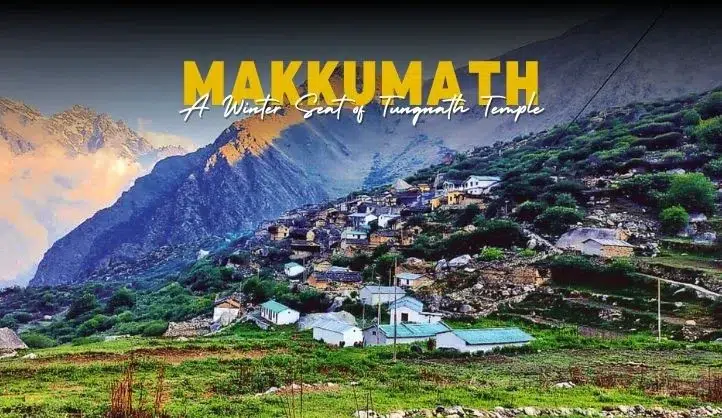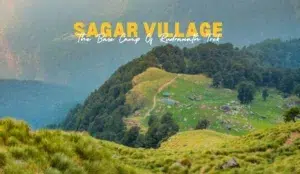Spiritual Significance – Winter Seat of Tungnath Temple
During the winter months, when the Tungnath Temple becomes inaccessible due to heavy snowfall, the idol of Lord Shiva is ceremoniously moved to Makkumath, a quiet village in Rudraprayag district. This relocation transforms Makkumath into the winter seat of Tungnath, allowing devotees to continue their worship without interruption.
The temple in Makkumath, often referred to as Markateshwar Temple, may be simpler in design than Tungnath, but it holds deep spiritual importance. Surrounded by peaceful forests and Himalayan silence, it offers a serene setting for prayer, reflection, and connection with the divine. This seasonal shift is not just practical, it is symbolic of the enduring devotion and adaptability of Himalayan spiritual traditions.
Would you like this section rewritten in a more poetic or emotionally resonant tone for your blog?
A Haven for Avian Enthusiasts
Makkumath is a dream come true for bird lovers. Surrounded by dense forests and perched in the Himalayan foothills, this quiet village offers a rare chance to spot some of the most beautiful and elusive birds in India. From the vibrant Himalayan Monal and Koklass Pheasant to the playful Red-billed Blue Magpie and Fire-capped Tit, the area is alive with color and song. Early mornings here are magical—mist rising from the valleys, birds calling through the trees, and the gentle rhythm of nature unfolding. Whether you’re a seasoned birder or just curious, Makkumath’s peaceful trails and rich biodiversity make it a perfect place to slow down and connect with the wild.
Trekking and Hiking Trails
Makkumath is not just a spiritual sanctuary, it is a launchpad for some of Uttarakhand’s most scenic and soul stirring treks. Whether you’re a seasoned trekker or a curious wanderer, the trails around this village promise a blend of natural beauty, cultural immersion, and quiet thrill.
Signature Treks from Makkumath
- Chopta–Tungnath–Chandrashila Trek One of the most iconic Himalayan treks, this trail begins near Makkumath and ascends through alpine meadows to the highest Shiva temple in the world—Tungnath. The final push to Chandrashila Peak rewards trekkers with panoramic views of Nanda Devi, Trishul, and Chaukhamba.
- Deoria Tal Trek via Sari Village Just a short drive from Makkumath, this gentle trek leads to a pristine lake surrounded by forests and snow-capped peaks. The reflection of Chaukhamba in the still waters of Deoria Tal is a photographer’s dream.
- Village-to-Village Hikes For those seeking cultural depth, hike to nearby villages like Hudu, Ushada, Mastoora, Tala, and Sari. These trails wind through rhododendron forests, terraced fields, and traditional Garhwali homes, offering a glimpse into mountain life untouched by urban rush.
Nature Walks and Birding Trails
Makkumath lies within the Kedarnath Wildlife Sanctuary, making it a haven for birdwatchers. Short hikes around the village reveal rare Himalayan species like the Fire-capped Tit, Himalayan Monal, and Verditer Flycatcher. These trails are ideal for slow travel, nature journaling, and mindful exploration.
Trails for Yoga & Meditation
The forested paths around Makkumath are perfect for walking meditations and sunrise yoga sessions. Imagine practicing pranayama with the scent of deodar in the air and the sound of rustling leaves as your soundtrack.
Makkumath serves as a base for several scenic treks:
| Trek Name | Highlights |
|---|---|
| Chopta–Tungnath Trek | World’s highest Shiva temple, alpine views |
| Chandrashila Trek | Panoramic Himalayan peaks |
| Deoria Tal Trek | Reflections of Chaukhamba on crystal waters |
| Village Trails | Hudu, Ushada, Sari, Tala—cultural immersion |
These trails offer a mix of spiritual depth and natural grandeur.
Yoga and Meditation
With its peaceful ambiance and minimal distractions, Makkumath is perfect for:
- Silent meditation retreats
- Outdoor yoga sessions
- Healing workshops and spiritual immersions
Its untouched surroundings make it a compelling destination for wellness travelers seeking authenticity.
Where to Stay
Accommodation options in and around Makkumath include:
- Snow Pod – Luxury eco-stay with panoramic views
- Village Retreat Resort – Ideal for cultural immersion
- Magpie Eco Retreat – Birdwatcher’s favorite
- The Meadows Chopta – Close to trekking routes
- Shivalik Guest House – Budget-friendly comfort
Pre-booking is recommended, especially during peak birdwatching and pilgrimage seasons.
How to Reach Makkumath
Tucked away in the Rudraprayag district of Uttarakhand, Makkumath is accessible yet blissfully remote—making the journey part of the experience. Whether you’re traveling from Delhi, Rishikesh, or Dehradun, here’s how to reach this Himalayan haven:
By Road
- From Rishikesh (Approx. 184 km) Drive via Devprayag–Srinagar–Rudraprayag–Agastmuni–Ukhimath–Bhiri–Makkumath. The final stretch from Bhiri (16 km) winds through pine forests and charming hill roads.
- Public Transport Buses and shared taxis are available from Haridwar and Rishikesh to Ukhimath or Rudraprayag. From there, hire a local taxi to Makkumath.
By Train
- Nearest Railway Stations – Rishikesh Railway Station (184 km) and Haridwar Railway Station (approx. 210 km) From either station, continue by road via bus or taxi. Rishikesh offers better connectivity for onward travel to the hills.
By Air
- Nearest Airport – Jolly Grant Airport, Dehradun (Approx. 200 km) From the airport, hire a cab directly to Makkumath or travel to Rishikesh and continue by bus or shared taxi.
Best Time to Visit Makkumath
Makkumath welcomes travelers year-round, but each season paints the village in a different hue—offering unique experiences for spiritual seekers, trekkers, and nature lovers alike.
Spring & Summer (March to June)
Why Visit: This is the most popular season, with pleasant temperatures (10°C to 24°C) and clear skies.
Highlights:
- Rhododendrons bloom across the forest trails.
- Ideal for trekking to Tungnath, Chandrashila, and Deoria Tal.
- Birdwatching is at its peak, with sightings of Himalayan Monal and Fire-capped Tit.
- Perfect for yoga retreats and nature journaling.
Monsoon (July to September)
Why Visit: Lush greenery and misty landscapes create a magical atmosphere.
Caution: Roads may be slippery or blocked due to landslides—check weather updates before planning.
Highlights:
- Fewer tourists, ideal for slow travel and introspection.
- Great for photography, especially cloudscapes and rain-kissed forests.
Autumn & Winter (October to February)
- Why Visit: Makkumath becomes the winter seat of Lord Tungnath, making it a spiritual epicenter.
- Highlights:
- Snow-draped peaks and crisp mountain air.
- Winter treks to Deoria Tal and Chopta are breathtaking.
- Cozy homestays and eco-retreats offer a warm refuge.
- Ideal for meditation, healing workshops, and cultural immersion.
Travel Tips
- Carry cash—no ATMs nearby
- Stock essentials at Augustmuni or Rudraprayag
- Electricity may be intermittent—charge devices in advance
- Respect local customs and temple protocols
Nearby Places to Explore
Chopta
Chopta is a Himalayan sanctuary where time seems to slow down. Nestled at 2,680 meters, this idyllic destination offers a poetic blend of alpine serenity and spiritual magnitude. With rhododendron forests, rare birdlife, and snow-laced peaks on the horizon, Chopta is a perfect escape for nature lovers and introspective trekkers.
Tungnath Temple
One of the five Panch Kedar shrines, Tungnath sits at an elevation of 3,680 meters, making it the highest Shiva temple in the world. The temple’s stone architecture whispers centuries-old legends, and every step toward it feels like entering a timeless hymn of devotion and silence.
Chandrashila Peak
Climbing just a little further from Tungnath leads you to Chandrashila, a summit that gifts trekkers with panoramic Himalayan views. Legends speak of Lord Rama meditating here, and as the sun spills across the peaks at dawn, the experience borders on transcendence.
Deoria Tal
Surrounded by forest and myth, Deoria Tal is a crystalline lake that reflects the Chaukhamba peaks with such clarity it feels surreal. A short trek from Sari village brings you to this sacred site that echoes stories from the Mahabharata and invites campers, dreamers, and storytellers.
Ukhimath
As the winter seat of Kedarnath, Ukhimath is steeped in spiritual richness. The town radiates mythological fervor, especially in its ancient Omkareshwar Temple. Visiting Ukhimath feels like walking through chapters of divine epics etched in stone.
Kalimath and Kalisheela
Kalimath honors Goddess Kali in her formless essence — through the enigmatic Sri Yantra. Just a trek away, Kalisheela is a mystic site carved with 64 yantras, where spiritual energy hums through black cliffs and mountain winds. This area pulses with deep feminine power and quiet mysticism.
Kanchula Kharak
Hidden amidst Chopta’s greenery, this sanctuary is home to the elusive musk deer and rare Himalayan pheasants. The silence of the forest here feels alive, offering nature walks that invite you to listen more than speak.
Conclusion
Exploring the trails around Chopta is not just about reaching peaks or ticking off destinations, it is a dance between nature and mythology, silence and soul-searching. Each village, temple, and glacial lake holds a story etched in folklore and framed by Himalayan grandeur. Whether you’re trekking beneath star-studded skies, meditating beside ancient shrines, or gazing into the mirror of Deoria Tal, this corner of Uttarakhand hums with timeless wisdom.
Frequently Asked Questions About Makkumath
Is Makkumath suitable for travelers seeking solitude and wellness retreats?
Absolutely. Makkumath’s serene atmosphere, minimal tourist footfall, and spiritual energy make it ideal for yoga, meditation, and healing retreats. Many travelers come here to disconnect and realign.
What kind of accommodation is available in Makkumath?
Makkumath offers basic homestays and eco-lodges run by locals. These are perfect for cultural immersion and budget travel. For more amenities, travelers often stay in nearby Chopta or Ukhimath.
Are there any local festivals or rituals unique to Makkumath?
Yes. During winter, when Tungnath Temple closes, the deity is ceremonially shifted to Makkumath. This transition is marked by rituals and local gatherings that reflect deep-rooted Himalayan traditions.
Is Makkumath accessible for elderly travelers or families with children?
Yes, but with some planning. The roads are motorable, and the village is walkable. However, those with mobility concerns should avoid trekking routes and opt for nearby spiritual sites like Ukhimath.
Can I find local guides or birdwatching experts in Makkumath?
Local villagers often double as informal guides, especially for birdwatching. Makkumath is a haven for Himalayan species, and hiring a local not only supports the community but enhances the experience.
Is Makkumath open year-round?
Yes, though winter months (December to February) can be chilly and occasionally snowy. It remains accessible and is especially significant spiritually during this time.
Are there any local foods or specialties to try in Makkumath?
While options are limited, you can enjoy Garhwali staples like mandua roti, pahadi dal, and seasonal vegetables. Some homestays offer traditional meals cooked on wood-fired stoves.
What kind of photography opportunities does Makkumath offer?
From misty forests and ancient temples to rare birds and Himalayan backdrops, Makkumath is a dream for nature and cultural photographers. Sunrise and twilight hours are especially magical.
Is it possible to volunteer or engage with the local community?
Yes. Some homestays and local NGOs welcome volunteers for eco-tourism, education, or cultural documentation. It’s a great way to give back while deepening your travel experience.
How far is Makkumath from major trekking routes?
Makkumath is strategically located near Chopta, Tungnath, Chandrashila, and Deoria Tal. It’s a peaceful base for exploring these trails without the crowds.





